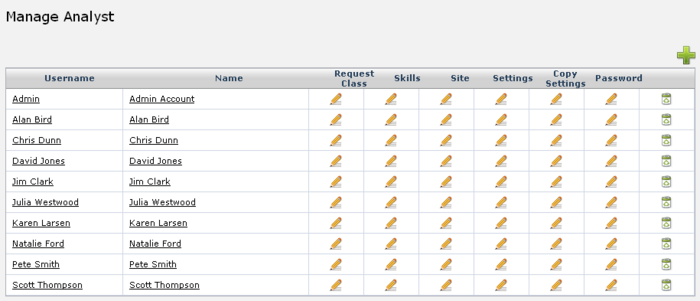Layton ServiceDesk - Settings - Company Structure - Manage Analyst
Contents |
Definition
Analysts can be front-line help desk personnel or second-line support or any level of support staff, as required. Analysts are defined using Administration > Company Structure > Manage Analyst where their Name, Password and Security Group or level of system access is defined. The two levels of Group Security provide Administrator access (All system functions available) and Standard access (Administration function not available). Support Analysts or second line support who have Requests assigned to them are normally given Standard access.
Other system fields are Manual Assign and Allow Auto Assign, which define whether the Analyst is available or allowed to receive assignment, either manually or automatically assigned to him/her. This is where Analysts can be selected as absent, i.e. on holiday, etc., but generally are both set to Yes.
Although you may be content with the default data fields and design, the screen and data content is configurable, so you can add, delete or change fields as required. You must always define new data fields before adding them to the form. See the Data Design section for information on how to add data fields, and the Form Design section for details on how to design or change forms.
The Manage Analyst section has a range of settings and access restrictions which are defined below:
General Settings
This section has settings which can Disable the Analyst, set their Home Screen and page Refresh Interval which can also be set by the Analyst in the Main Menu > Settings section. Any settings changes will not take effect until they log in again.
Access Restrictions
This area defines access restrictions pertaining to the Analyst, for viewing requests, running Reports and viewing Statistics, allowing Request Ownership & Assignment, as well as other options.
Site Access
This area defines Site access restrictions for the Analyst. For example, you may want to restrict Analysts to only access Requests and Statistics at their Site. This also controls access to White Board Messaging and Incoming Email access.
Comment
This area defines Comment privileges, whether Analysts have the ability to edit, delete, make and view public/private.
Escalation & Overflow
You can enter email addresses here to send out escalation notifications based on the individual analyst which are separate from the general Priority escalation configuration emails. If you enter the Analyst's own email address or that of their manager's, when a request that is assigned to this Analyst escalates it will send an email notification to this email address, in addition to the email that is sent out based on the Priority escalation email settings.
Other Settings
Each Analyst has a number of individual settings which are categorized in a Tab view. These are accessed through the Manage Analyst screen by clicking the Edit button in the Settings column for the Analyst required.
Request Class
This Analyst setting determines which Request Classes the Analyst will have access to. Request Classes are a powerful feature which provides the ability to define multiple request forms for different types of Requests such as IT Incident, Service Request, New User Requests etc. See the Request Classes section for more information.
Skills
Analyst skills or job responsibilities are directly linked to the Request Types used for categorizing Requests and one of the methods that Layton ServiceDesk can use to automatically assign requests. They are also used to automatically prompt and assign which Analyst is best suited or have the appropriate skills for a particular Request. These can be entered later when the Request Types are completed, or at any time.
To input Skills select the edit button under the Skills column for the Analyst. A pop up screen will display the Request Types hierarchy and you can simply select the appropriate Skill (Request Types) for this Analyst. An Analyst can have any number of skills or Request Types but use the highest level in the tree structure possible to cover their skills. For example, a network specialist would probably have all network issues assigned to him so the Request Type Network Issues would be selected although there may be a number of sub levels or specific Request Types in the structure below Network Issues. See the Request Type section for further details.
Site
If you have defined multiple sites then you may specify at which sites analysts are by clicking the edit button in the Sites column from the Manage Analyst page. These are the sites at which the Analyst works or is responsible for manage requests from End Users at these Sites. They can be added and removed as Skills are.
Next article in this series: Manage Analyst Group
